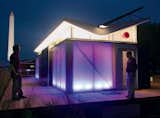Let the Sun Shine In
Although the University of Colorado Buffaloes football team fell short during bowl season, another dynasty is afoot at the idyllic Boulder campus. In October 2005, the University of Colorado team defended its championship at the Solar Decathlon, a nine-day-long competition hosted by the U.S. Department of Energy in Washington, D.C. After taking the crown at the inaugural decathlon in 2002 and again this past autumn, University of Colorado faculty advisor and professor Julee Herdt is starting to look like the Joe Paterno of collegiate architecture.
Teams from the United States, Puerto Rico, Canada, and Spain made the trek to D.C. to erect their small, solar-powered houses, transforming the soggy fields on the National Mall between Smithsonian museums into a high-tech village. The 18 teams competed in ten categories to build the most attractive, effective, and energy-efficient solar houses. Each house—a modest two-person dwelling replete with home office and the latest in energy-efficient appliances—was designed to absorb sunlight, which was converted into electricity and stored in batteries.
More than just an architecture competition, the Solar Decathlon is an open-to-the-public trade show boasting the latest in solar and energy-saving technologies (some pioneered by the contestants themselves) that you can actually imagine using in your own home. In sponsoring the event, the Department of Energy wants to spread the gospel of solar power—a message we hope was heard a few blocks east at the Capitol.
With teams already lining up for the 2007 and 2009 competitions, we wondered what happened to the 2005 houses that impressed us with their ingenuity, style, and eco-savvy construction. Are these solar-powered gems finding homes of their own?
Virginia Tech’s translucent home took first place in both the Dwelling and Architecture categories, netting a perfect score in the latter. The concave swoosh of a roof suggested the sun-drenched drive-throughs of mid-20th-century California, but the translucent walls, which became glowingly opaque by night, were the real stars. Professor Bob Schubert, one of the team’s advisors, tells us that the house is due to hit the road after a lengthy stay on the Virginia Tech campus. "It’s a highly mobile house and our goal is to move it around the state, to take it on tour." This dreamy little domicile will make stops at the Science Museum of Virginia in Richmond, the Belmont Bay Science Center in Woodbridge, and the National Building Museum in D.C.
"We want to study the long-term performance of the house," says Schubert. "What we did on the Mall was great, but we really want to see how this house will do down the road."
California Polytechnic State University had the longest overland journey for their entry, hence their emphasis on portability and the so-called "one-truck solution." Their highly mobile modular home captured third place and, perhaps more importantly, found an application that is as humanitarian as it is utilitarian. Professor Rob Peña says of his students’ design, "We’ve been in conversation with a Pakistani developer in the U.K. to do earthquake-relief housing in Pakistan. They want the team involved with the solar electric part of their project."
He continues, "They’re thinking of a pared-down version of what we presented at the Solar Decathlon. They imagine that most of the heating will be done by wood-burning stoves, and the solar panels would be used for refrigeration, lighting, and appliances." The relief houses wouldn’t feature all the amenities found in the Solar Decathlon design, but by virtue of being portable and independent of local infrastructure, they could be a perfect fit for those in need of immediate shelter.
And what have the reigning sun kings of the University of Colorado done with their house since the competition?
Herdt says that the nautically christened BioS(h)IP was sold before the competition even got under way on the Mall. "The house was pre-sold to Prospect New Town, a New Urbanist development in Longmont, Colorado." But the Boulder builders are hardly resting on their laurels: "We want to keep making homes that inspire us, keep us protected, and pay the bills."
With Colorado and other contenders already signed up for the 2007 competition, the forecast is decidedly sunny.
Virginia Tech’s VT Solar scored the highest in both the Architecture and Dwelling categories. The south, east, and west walls are constructed of two panels of thin translucent polycarbonate, which was filled with aerogel insulation. LEDs, which can display a range of millions of colors, light the panels from within.
Published
Last Updated
Get the Dwell Newsletter
Be the first to see our latest home tours, design news, and more.



